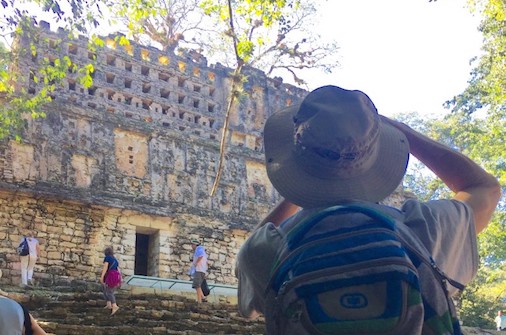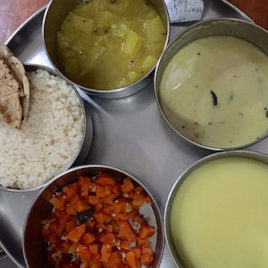Today’s post is by guest blogger Bob Sessions. Bob was a participant on our “Maya Temples of Transformation with Freddy Silva and Miguel Angel Vergara” journey – this blog piece is the final instalment in a series about the journey. Earlier posts, written by Lori Erickson, explore the sacred sites of Tikal and Palenque, and the mysteries of Mayan ceremonies.
In 2000 I found this smooth piece of rock while walking along the beach near the scenic seaside town of Whitby, England. I’ve carried it in my pocket nearly every day since then, using it both as a worry stone and a reminder of a wonderful semester spent teaching and traveling in Great Britain.

So when our shaman guide, Miguel Angel Vergara, invited us to place a sacred object in the ceremonial circle at our Yaxchilan ritual (see Lori’s post A Ceremony Amid Sun-Dappled Mayan Ruins), it seemed natural that this well-traveled stone would find its way into the ritual.
My little, jet-black stone now reminds me of our travels in Mexico and Guatemala with Sacred Earth Journeys as well as our time in England. In particular, it helps me remember the powerful spiritual experiences I had in these Mayan holy sites.
It might be surprising that I had those experiences, as I’m not Mayan, nor do I have any Native American ancestry. In reflecting on what I experienced, I hope to give some insight on what visitors can gain from participating in rituals in a tradition not their own.

Many pilgrims visit sites that are within the fold of their own faith. But often people journey to holy sites of other traditions – or encounter differing strands of belief at the same site. When visiting Jerusalem, for example, travelers often meet fellow pilgrims from other faiths.
Over the years I’ve visited many holy sites from non-Christian traditions and have learned a great deal about the cultures and histories of the people who created them. But until our Maya trip, I never tried to enter into the spiritual dimensions of those traditions in an experiential way. Christianity is so rich with possibilities that it would take many lifetimes to explore. Besides, I am not a Buddhist, Hindu, Lakota or Maori.
Furthermore, through my studies of Native American philosophies I’ve become sensitive to the problem of want-to-be’s, also known as wannabes. While most people are well-meaning in their interest in other spiritual traditions, it can at times become merely cultural appropriation.
So it was a stretch for me during our first ceremony at Yaxchilan as we prayed to the four directions, drummed, and chanted. I could see other visitors to the site glancing at us with curiosity, and perhaps disapproval.
Most of us in the group didn’t want to be Mayans, but we were eager to experience their spiritual worldview. And after coming home, I find myself wondering this: Did our journey to these Mayan holy sites enhance our spiritual lives once we returned to our familiar routines?
For me, at least, the answer is yes.

One of the things I came to see is that Mayan traditions are not that different from Christianity in some ways. The goals of their rituals were familiar to me: they were designed to help us worship, to experience gratitude, and to get in touch with the spiritual powers that underlie ordinary reality.
We thanked the forest and its creatures (as did St. Francis and many other Christian mystics over the centuries), we drummed and chanted, and we sought to become open to the powers around us.
In particular, I found the drumming and chanting to be much more effective than most word-centered Christian rituals for helping me enter a deeper state of consciousness. The “book of nature” has long been my entry point into the Christian faith, so one of my main reactions to our Mayan rituals was to wish that we had similar practices in our church back home – and that we could do more of them outside, instead of inside a building.
I came to realize, too, that the Mayans are polytheists in the same way Hindus are: they believe there are many manifestations of the holy and that each can be an aide or guide to connect with the One. Thus it’s really not surprising that many people in Central America are both Catholics and followers of Mayan traditions. We saw this blending in a Day of the Dead festival in Chicago last fall, where the altar tributes to dead loved ones often contained Mayan or other indigenous symbols alongside Catholic ones.

Before this trip, I thought that participating in an unfamiliar ceremony in another country would make me so self-conscious that deep spiritual experience would be impossible. But I’m delighted that I was able to dive deeply into the meditative worship in the remarkable Mayan holy sites we visited. I learned things that can only be learned on pilgrimage, lessons that I think will continue to enrich my spiritual life at home.
~Bob Sessions
This article was first published at: http://www.patheos.com/blogs/holyrover/2017/02/28/12548/

